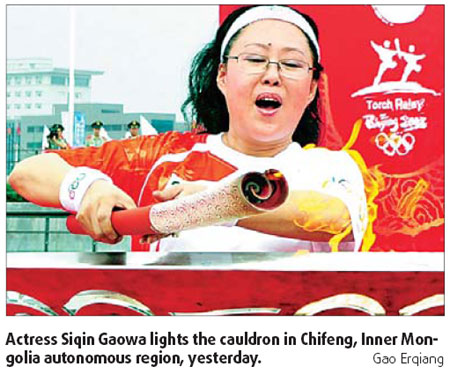
The Olympic torch relay concluded its Inner Mongolian autonomous region leg yesterday, when Chinese actress Siqin Gaowa lit the cauldron at Chifeng, the relay's fourth and final stop in the region.
"It is more than an honor to carry the torch in my hometown," the final torchbearer said. "This is the brightest moment of my life."
The 59-year-old Chifeng native is one of China's most famous actresses, lauded for her diligence and versatility.
Since 1979, she has performed in dozens of award-winning TV series and films.
The Mongolian woman explained the torch had a special meaning for her.
"I believe the torch, which features an auspicious cloud pattern - a symbol Mongolians use in daily life, on our clothing, tents and even utensils - will bring us luck," she said.
"And I also hope the torch will serve to remind us of the Olympic spirit, making the world a better place."
The Mongolian woman is also an astute equestrian but admits she finds it challenging to ride while filming chaotic shootout scenes. She has fallen three times while filming such scenes and has since suffered from avascular necrosis - a disease restricting blood flow to the bones that makes walking and running difficult.
But she has never let her illness get in the way of her career.
"Whenever I finish shooting a film, I feel like I'm winning a gold medal," she said. "It is an actor's perseverance and constant learning that helps one bring a film character to life, and it seems this is a similarity between athletes and actors."
The Chifeng relay is intended to highlight the city's legacy as the birthplace of Hongshan Neolithic Culture (3800 BC to 2700 BC). Its most representative symbol, the coiled dragon, was printed alongside Olympic symbols on banners, stage backdrops and signs.
Hongshan culture was discovered in 1935, and since then, more than 20 cirrus-shaped jade items have been unearthed at a site near Chifeng's Wuerjimulun River Valley.
(China Daily July 11, 2008)